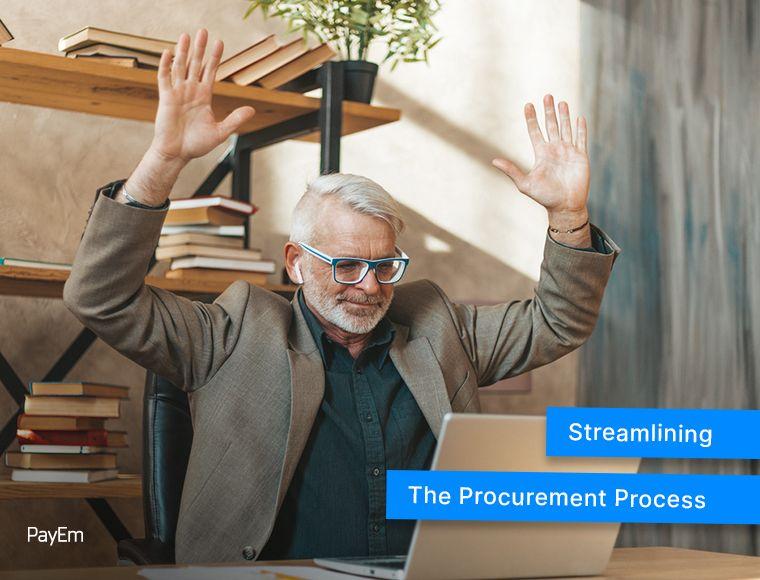November 03, 2022
Streamlining The Procurement Process

Sign up for our newsletter
Stay informed with the latest trends and best practices in finance and procurement.

Procurement has shifted from a standard accounting operation to an essential function of an organization. It goes beyond just the purchase of goods and services and has become central to managing each aspect of the buying process, including approvals, invoicing, and, most significantly, supplier relations. While negotiating with suppliers, some risks can arise which will need to be taken into account. Considering this, one of the best things a business can do is streamline procurement to avoid these risks and optimize the procurement cycle.
This article will cover the following topics:
- The risks that can occur from unoptimized procurement processes
- Locating procurement bottlenecks
- Tips businesses can use to streamline their procurement processes
- How can businesses monitor and streamline their procurement process
What risks may result from unoptimized procurement processes?
The procurement process is multifaceted, with many moving parts. As such, it can be challenging to streamline, which can create risks through each stage of the procurement cycle, from signing off on contracts to negotiating with vendors. Becoming cognizant of these risks is the first step toward risk mitigation to ensure an effective procurement process.
Risks of not creating a streamlined procurement process include:
1. Subpar negotiation skills: When negotiating with suppliers, it is essential to know how to arrange the best terms to ensure success. Procurement teams engage in challenging negotiations that, if not handled well, can result in a risk for the company.
2. Confidentiality breach: When proprietary information is shared, security breaches can ensue, putting sensitive company data at risk.
3. Misplaced trading agreements: There is a heavy paper trail when the procurement process is not automated. This is especially true in regards to trading agreements. Misplaced trading agreements can become an extreme challenge.
4. Erroneous data: Access to accurate and updated information is essential for making sound procurement-related decisions. For instance, if erroneous rebate data is present, overall profitability can be affected.
5. Missed agreement deadlines: There are expiration dates and deadlines involved with a majority of trading agreements. If these are missed, it can impact the relationship with the supplier and customers, putting the business at risk.
Where might procurement bottlenecks occur?
Bottlenecks can occur in the procurement process, which may inhibit the natural flow of business, thereby resulting in an inefficient procurement process.
Supplier communication
One of the bottlenecks that a business may run into includes challenges associated with supplier communication. Once communication with suppliers has been compromised due to faulty information, or if the wrong personnel handle communications, the overall procurement process may be severely impacted.
Supplier shipment
In addition to bottlenecks in communication, another problematic area is when there are supply issues that affect the delivery of vital goods and services. When this occurs, it is essential to consider diversifying the supplier base to mitigate these risks.
Miscommunication between key stakeholders
Communication between key stakeholders is nothing short of essential throughout the procurement process. Conversely, miscommunication between key personnel about important procurement decisions can impede a business’s overall procurement process.
Tips for businesses to streamline their procurement processes
The effectiveness of a procurement process is contingent upon how well the organization can eliminate ineffective practices and avoid bottlenecks within the procurement system. There are many ways to improve the procurement process, including minor and major adjustments according to best practices. Exploring the best methods to streamline the procurement process within an organization will ensure greater efficiency and profitability.
Procurement best practices include:
1. Create efficient processes
By creating efficient processes, a business can have enhanced functionality, thus leading to greater efficiency. With clearly defined processes in place, procurement teams can better understand which tasks to prioritize. This reduces wasted time, minimizes cost, and enhances productivity.
2. Implement automated procurement tools
Manual processes are inherently prone to error which is why one of procurement’s best practices involves automation. With automated tools, a business can better improve its procurement processes and reduce the margin for error to ensure success.
3. Put a multi-sourcing strategy in place
Having one or a limited number of suppliers in the procurement chain poses a considerable risk for any business. One of the most effective ways to streamline the procurement process is to diversify the supply chain by having a sufficient supply of dependable vendors. Multi-sourcing is the best solution to reduce reliance on a limited number of suppliers and create stability in the procurement process.
4. Establish secure supplier relationships
With secure supplier relationships, businesses can better avoid supply chain disruptions that could set them back. Procurement systems considered to be high functioning have strong supplier relationships that reduce bottlenecks and ensure efficient flow in the procurement process. With a strong relationship, the supplier can act as an asset, providing product information and relaying issues and changes in advance to support the business.
Additional tips to streamline procurement include:
- Develop a highly trained procurement team
- Utilize data for optimized inventory
- Create a contract and documentation hub
- Utilize transparent procurement processes
- Ensure compliance to maintain procurement standards
- Improve supplier negotiations
How can companies monitor and streamline their procurement processes?
Companies can streamline and monitor their procurement processes by using automation to replace outmoded methods. By eliminating manual approaches, the procurement team can focus on other critical tasks. This saves time and resources and improves the overall efficiency of the procurement process. One of the leading-edge automation solutions for procurement is known as PayEm. PayEm offers a dynamic user experience where all procurement team members can easily collaborate. As a fully-featured all-in-one platform, PayEm easily addresses the question of how to streamline the procurement process.
Some of the benefits of using PayEm include:
- Ensure budget compliance with real-time spend data
- Streamline procurement payments in alignment with company spend objectives
- Get data on PO usage and budget metrics
- Save time during month-end reconciliation
- An all-in-one platform that houses a company’s full expense management needs
- Utilize a customized approval flow
- Easily automate approvals
Contact PayEm’s experts to book a commitment-free, no-cost demo of the platform today.


